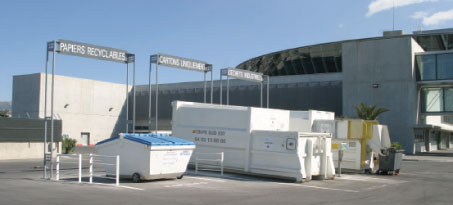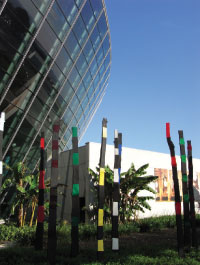
Nice Côte d’Azur Airport’s comprehensive recycling programme involves sorting waste paper, glass, wood and green waste.
Nice Côte d’Azur handled 10.4 million passengers in 2008, with 183,000 aircraft movements – making it the third busiest airport in France. It is one of the keys to economic development on the French Riviera. Previously managed by the regional Chamber of Commerce & Industry, in June 2008 the governance of the airport changed to that of a limited company. The Côte d’Azur Airports limited company groups together the Nice Côte d’Azur and Cannes-Mandelieu airports and the new concession runs for 37 years to 31 December 2044.
Nice Côte d’Azur’s commitment to a long-term holistic approach on the environment began in 1997, with an emphasis on consultation and dialogue with neighbourhood groups, associations and air transport stakeholders. The result was an Environment Charter; the latest version of which was signed in October 2006 and covers the period to 2010. “In parallel to a charter for local resident populations we have an environmental policy with four axes: Control of energy and natural resources, anticipation of the regulation of greenhouse gases, integrating development in the biodiversity and landscape pattern, and create a network of eco actors,” said Vandrot. “The new environment charter marks a step forward in such agreements as for the first time all the actors involved have undertaken to join this partnership.”
Apart from the Chamber of Commerce & Industry, those taking part include the Departmental Council, the Regional Council, the Nice and Sophia Antipolis urban District councils, airline companies, pilot associations and local associations, all of which form part of the environmental consultancy commission.
Air quality and noise monitoring

In terms of monitoring air quality, Nice Côte d’Azur has acquired air quality analysers, which are installed in a station in the middle of the airport site very close to the runways.
The airport’s biggest environmental challenges are noise and air quality. “It’s easier to accuse aircraft of all the pollutions and we don’t have any way to distinguish pollutants coming from planes from others coming from other sources, such as heaters, cars etc,” said Vandrot. “As everywhere, noise is the first nuisance for people living around an airport. What is particular at Nice Airport is that most of the trajectories are above the sea during their low level parts, but we also have people living just on the other side of the airport fence.”
The comprehensive strategy to reduce noise pollution means that night flights by the noisiest aircraft are banned, motor tests are banned during the evening and at night, and aircraft operators are required to publish noise reduction instructions for takeoff and landing in their manuals.
The airport also makes effective use of continuous descent approaches, which Vandrot explained are very efficient in the last 20km; aircraft approaching Nice travel over the sea for more than 10km before landing.
In terms of monitoring air quality, Nice Côte d’Azur has acquired air quality analysers, which are installed in a station in the middle of the airport site very close to the runways. Emissions, from sources such as boilers, heaters and air conditioning, are closely monitored.
While carbon neutrality is not yet a specific project target of the airport, it is very supportive of the ACI EUROPE’s forthcoming Airport Carbon Accreditation Scheme, which will aim to guide airports towards carbon reductions and ultimately carbon neutrality. “It is a very good idea, well adapted to airport management and trying to avoid confusion with air transport emissions. At Nice Airport we wait for this scheme to be available to be taken into account as soon as possible,” said Vandrot.

The airport has launched a project to generate electricity by photovoltaic cells as part of its policy of sustainable development and reduction of CO2 emissions.
A Company Commuters Plan was officially launched in December 2008 as a means of minimising the CO2 generated by staff travelling for professional reasons or to and from work. “A survey was realised in 2007 in order to define the use of modes of transport and the attempts of the employees. A plan of action has been established and will be achieved in 2009. This plan is split in three axes – public transport, car pool and use of bicycles,” said Vandrot.
Employees using public transport will receive a yearly subsidy of 150; a special website was set up to facilitate contact between employees interested in the car pool scheme; and secure storage for bicycles is offered, which includes availability of a security kit containing a helmet, safety light, pump, high visibility vest, and first aid emergency tools.
Alternative energy
The airport is committed to finding alternative sources of energy and is launching a project to generate electricity by photovoltaic cells. “This project is a part of our policy of sustainable development and reduction of CO2 emissions. These cells will supply a photovoltaic energy production unit located on the roof of the large P5 car parking area, nearby Terminal 2,” said Vandrot. She added “Such a project is quite new in the region and it will be interesting to see the impact this will have on the airport’s drive to achieve environmental efficiencies.”
The total area will cover 6,600sqm and the annual production will be around 1GW/h/year (the airport consumption is 45GW/h/year). This project will be financed by a private company, with return on investment generated by selling the power to the French supplier EDF. Construction is planned from the end of 2009 to mid-2011.
Nice Côte d’Azur has a strong commitment to achieving environmental efficiencies, as is evidenced by its Environment Charter. Environmental considerations are at the forefront when planning infrastructure projects. “We have environmental targets – water consumption, energy use, waste management – which must be integrated into any project. Our future building will be of High Environmental Quality, with improved energy performance,” said Vandrot.







